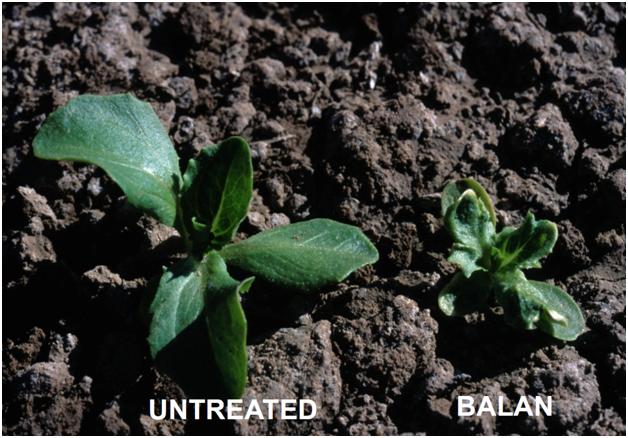 |
|
|
|

|
|||
| |
|||
Balan (Benefin) is one of only three principal herbicides used on lettuce. Our surveys indicate that fewer acres are treated with Balan than are treated with Kerb or Prefar and it is commonly used in combination with one or both of these. Balan is in the dinitroaniline herbicide family that includes some of the most important herbicides used worldwide. The first dinitroaniline herbicide registered was Trifluralin (Treflan) in 1960. Within the next 10 years, others in this family including Pendemethalin (Prowl), Ethalfluralin (Sonalan, Curbit) and Oryzalin (Surflan) were registered. These herbicides are typically bright yellow and were originally discovered when evaluating chemicals for dyes. Unlike Kerb and Prefar, Balan is normally put on before beds are listed and shaped. It is fairly volatile, will evaporate into the air and is also subject to photodegradation. Because of this, it is normally mechanically incorporated within hours of application. The label suggests 4 hours although volatility will vary with moisture and temperature. Balan adheres strongly to the soil and is difficult to incorporate with water. It should be mechanically incorporated. Shallow incorporation will help to avoid diluting it too much in the soil. Flat incorporation, listing and shaping make it difficult to concentrate this herbicide in the bed top where it needs to be. It is tempting to mulch Balan into the bed top after listing. This will improve weed control but greatly increases the chance of crop injury. Like other dinitroanaline herbicides, Balan is good on many grasses and will control some broadleaf weeds such as pigweed and lambsquarters but is less consistent on broadleaves. The application rate of the DF formulation varies little from 2.0 lbs./ac on coarse textured soils to 2.5 lbs./ac on finer textured soils. Balan moves little in either the soil or the plant. It stops cell division in roots and shoots that contact it. Roots that are out of the zone where the herbicide is concentrated will grow normally. Although this herbicide moves very little in the crop or weeds, crop injury can often be seen in the first true leaves which appear stunted and distorted. Balan breaks down by anaerobic degradation or in areas where water stands and oxygen is limited. On well drained soil it will normally persist for 4 to 6 months. Balan Symptoms in Lettuce Click picture to listen to Barry To contact Barry Tickes go to: btickes@ag.arizona.edu. |
|||
| Back | |||
For questions or comments on any of the topics please contact Marco Pena at the Yuma Agricultural Center. |
|||
| Home | Cotton
| Veggies | Forages
| Grains | Citrus
| Crop x Crop Insects | Diseases| Weeds | Pesticides | Economics | News | Weather | Research | Photos | Contacts | General Info. Copyright © 2001 University of Arizona, College of Agriculture and Life Sciences Webmaster: Al Fournier (acis@ag.arizona.edu) |
|||

